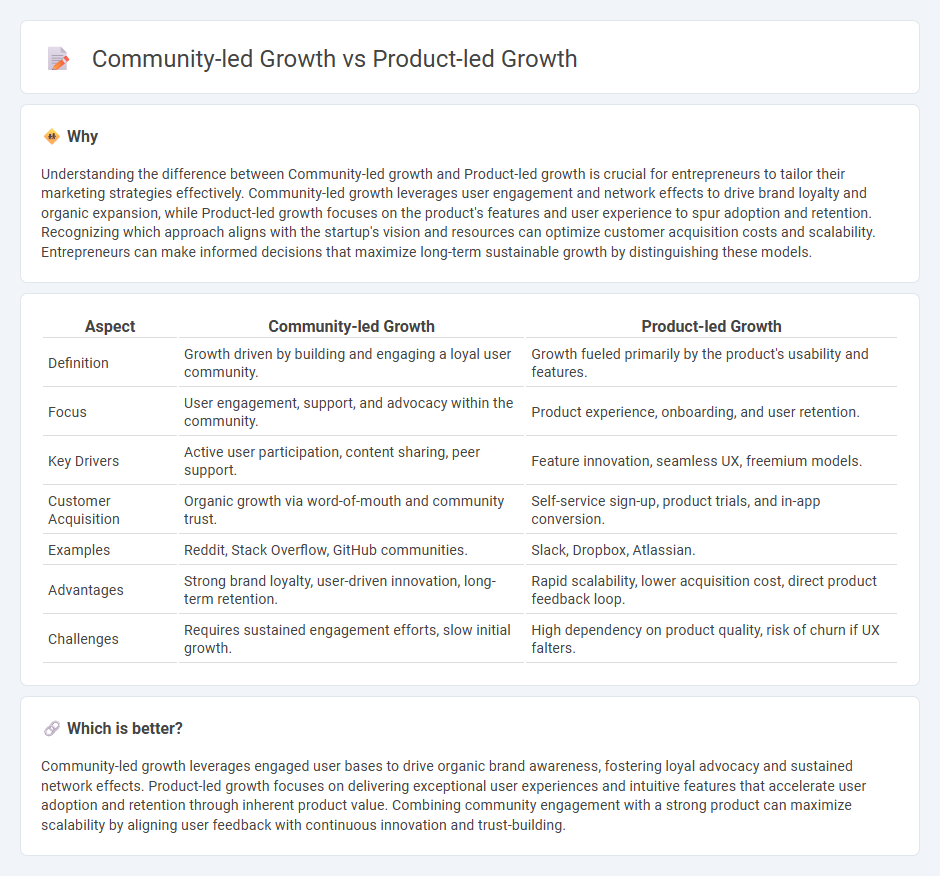
Community-led growth leverages active, engaged user communities to drive product adoption and brand loyalty, fueling organic expansion through peer influence and shared experiences. Product-led growth focuses on delivering a superior user experience and product value that naturally attracts and retains customers without heavy reliance on sales or marketing efforts. Discover how these contrasting strategies can accelerate your startup's success and which approach aligns best with your business goals.
Why it is important
Understanding the difference between Community-led growth and Product-led growth is crucial for entrepreneurs to tailor their marketing strategies effectively. Community-led growth leverages user engagement and network effects to drive brand loyalty and organic expansion, while Product-led growth focuses on the product's features and user experience to spur adoption and retention. Recognizing which approach aligns with the startup's vision and resources can optimize customer acquisition costs and scalability. Entrepreneurs can make informed decisions that maximize long-term sustainable growth by distinguishing these models.
Comparison Table
| Aspect | Community-led Growth | Product-led Growth |
|---|---|---|
| Definition | Growth driven by building and engaging a loyal user community. | Growth fueled primarily by the product's usability and features. |
| Focus | User engagement, support, and advocacy within the community. | Product experience, onboarding, and user retention. |
| Key Drivers | Active user participation, content sharing, peer support. | Feature innovation, seamless UX, freemium models. |
| Customer Acquisition | Organic growth via word-of-mouth and community trust. | Self-service sign-up, product trials, and in-app conversion. |
| Examples | Reddit, Stack Overflow, GitHub communities. | Slack, Dropbox, Atlassian. |
| Advantages | Strong brand loyalty, user-driven innovation, long-term retention. | Rapid scalability, lower acquisition cost, direct product feedback loop. |
| Challenges | Requires sustained engagement efforts, slow initial growth. | High dependency on product quality, risk of churn if UX falters. |
Which is better?
Community-led growth leverages engaged user bases to drive organic brand awareness, fostering loyal advocacy and sustained network effects. Product-led growth focuses on delivering exceptional user experiences and intuitive features that accelerate user adoption and retention through inherent product value. Combining community engagement with a strong product can maximize scalability by aligning user feedback with continuous innovation and trust-building.
Connection
Community-led growth leverages user engagement and advocacy to drive product adoption and brand loyalty. Product-led growth relies on a seamless product experience to attract, retain, and expand the customer base through user satisfaction and organic referrals. Together, these strategies create a feedback loop where a strong community fuels product improvements and product excellence enhances community growth, accelerating entrepreneurial success.
Key Terms
User Experience
Product-led growth leverages an intuitive and feature-rich user experience to drive customer acquisition and retention by empowering users directly within the product interface. Community-led growth emphasizes building strong user communities that foster collaboration, feedback exchange, and social proof, enhancing overall satisfaction and engagement. Explore how integrating these strategies can optimize your user experience for sustainable growth.
Network Effects
Product-led growth leverages a company's core product to drive user acquisition, retention, and expansion, optimizing the user experience to generate organic growth through direct value delivery. Community-led growth harnesses the power of network effects by building engaged user communities that amplify product adoption via peer recommendations, social proof, and collaborative interactions. Explore how these growth strategies uniquely capitalize on network effects to scale your business effectively.
Retention
Product-led growth (PLG) drives retention by offering seamless user experiences and continuous value through product features, enabling customers to self-serve and realize benefits rapidly. Community-led growth (CLG) enhances retention by fostering strong user engagement, peer support, and shared knowledge, creating a sense of belonging that encourages long-term loyalty. Explore how combining PLG and CLG strategies can maximize retention and accelerate sustainable growth.
Source and External Links
What is product-led growth? - Product-led growth (PLG) is a business approach where user acquisition, expansion, conversion, and retention are driven primarily by the product itself, aligning all company teams around delivering the best user experience through the product.
Product-Led Growth (PLG): What it means, examples, and why it's ... - PLG is a strategy that has every team in the company focusing on the product to create self-service, shorten sales cycles, improve user experience, lower customer acquisition costs, and achieve scalable growth.
Product-Led Growth: What It Is and Why It's Here to Stay - Product-led growth is a strategy where the product enables self-service discovery and use by customers, eliminating friction and driving acquisition, retention, and expansion efficiently, especially in B2B markets.
 dowidth.com
dowidth.com